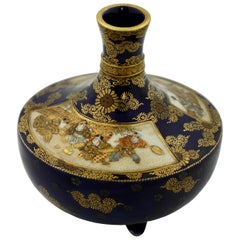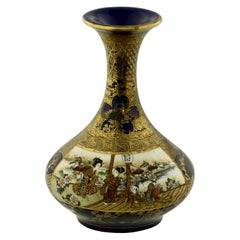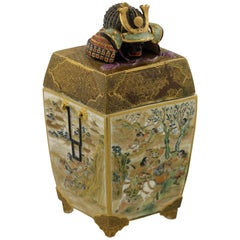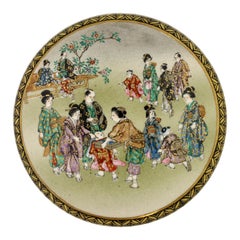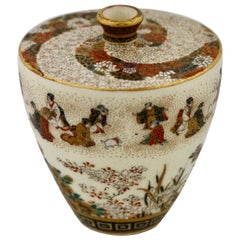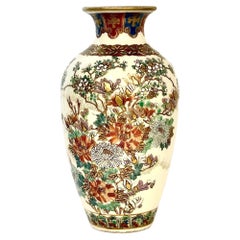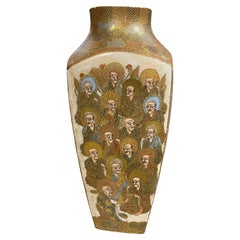Satsuma Furniture
6
to
6
6
6
6
3
3
3
3
6
5
19
60
24
22
22
Creator: Satsuma
Dealer: A.B. Levy's
Satsuma Earthenware Vase, by Kinkozan
By Satsuma
Located in West Palm Beach, FL
A Satsuma earthenware vase,
by Kinkozan,
Japanese, Meiji period (1868-1912)
decorated in polychrome enamels and gilt over a clear, crackled glaz...
Category
Early 1900s Antique Satsuma Furniture
Materials
Earthenware
Satsuma Earthenware Vase, by Kinkozan, Japanese, Meiji Period
By Satsuma
Located in West Palm Beach, FL
A Satsuma Earthenware Vase,
by Kinkozan,
Japanese, Meiji period (1868-1912)
decorated in polychrome enamels and gilt over a clear, crackled glaze, delicately painted with ladies and men, the reverse with a flowering garden with sprays of flowers, the neck with geometric and floral designs, a band of kifu heads in silver and gilt above the foot, on a midnight-blue ground, signed Kinkozan zo...
Category
1860s Antique Satsuma Furniture
Materials
Earthenware
Satsuma Earthenware Vase and Cover, Japanese, Meiji Period
By Satsuma
Located in West Palm Beach, FL
A Satsuma Earthenware vase and cover,
Japanese, Meiji period, (1868-1912)
decorated in polychrome enamels and gilt over a clear, crackled glaze, delicately painted with samurai on ...
Category
1890s Antique Satsuma Furniture
Materials
Ceramic
Satsuma Earthenware Covered Box, by Kinkozan
By Satsuma
Located in West Palm Beach, FL
A Satsuma Earthenware covered box,
by Kinkozan,
Japanese, Meiji period (1868-1912)
decorated in polychrome enamels and gilt over a clear, crackled glaze, delicately painted with s...
Category
Early 1900s Antique Satsuma Furniture
Materials
Earthenware
Satsuma Earthenware Flat Shouldered Ovoid Vase, Garlic Mouth by Yabu Meizan
By Satsuma
Located in West Palm Beach, FL
A Satsuma earthenware flat shouldered ovoid vase with garlic mouth by Yabu Meizan,
Osaka, 1853-1934,
decorated in polychrome enamels and gilt over a cle...
Category
1890s Antique Satsuma Furniture
Materials
Earthenware
A Satsuma Earthenware Incense Burner by Yabu Meizan, Osaka, 1853-1934
By Satsuma
Located in West Palm Beach, FL
A Satsuma Earthenware Incense Burner by Yabu Meizan,
Osaka, 1853-1934,
Of archaic Chinese form set on tripod feet and decorated in polychrome enamels and gilt...
Category
Early 1900s Antique Satsuma Furniture
Materials
Earthenware
Related Items
Antique Japanese Meiji Satsuma Painted Vase
By Satsuma
Located in LA CIOTAT, FR
A petite and beautiful hand-decorated ceramic baluster vase, painted all around with traditional Japanese motifs, including native flora, birds and bamboo stems on a creamy glazed background. The colour palette is bold and bright, with highlights of green, red and blue, together with plentiful gilt relief...
Category
19th Century Japanese Meiji Antique Satsuma Furniture
Materials
Ceramic
Japanese Antique Satsuma Pottery Buddhist Monks Vase with Shimazu Crest Mark
By Satsuma
Located in Studio City, CA
A beautiful Japanese Satsuma pottery studio vase featuring multiple kesa-clad enlightened Buddhist monks on each side of the vase. The piece is finely detailed with rich raised gilt highlights throughout and beautifully decorated in gold and various hand painted other colors.
From the Meiji period (1868-1912).
This piece has the all-important Shimazu Family crest mark (red circle with a cross inside) on the base authenticating the work as an old and original Satsumaware work. The mark shows the pottery was made under the rule of the Shimazu clan.
From a Los Angeles Collection...
Category
Early 20th Century Japanese Meiji Satsuma Furniture
Materials
Earthenware, Pottery
H 11.5 in W 4.5 in D 4.5 in
Japanese Porcelain, Satsuma Tea Set, 23 Pieces
By Japanese Studio
Located in Milano, IT
...
Category
1950s Japanese Japonisme Vintage Satsuma Furniture
Materials
Porcelain
Magnificent Antique Japanese Satsuma Vase, Meiji Era, Signed
Located in London, GB
A fine antique Japanese Satsuma vase.
Meiji period. Signed.
A very nice 19th century Japanese Satsuma ware vase of a relatively ...
Category
Late 19th Century Japanese Antique Satsuma Furniture
Materials
Ceramic, Porcelain
Meiji Period Diminutive Satsuma Baluster Vase.
By Satsuma
Located in Vero Beach, FL
Meiji Period Diminutive Satsuma Baluster Vase.
This Japanese Satsuma vase from the late Meiji period is hand painted and gilt decorated with a Japanese landscape in exquisite detail...
Category
20th Century Japanese Meiji Satsuma Furniture
Materials
Porcelain
Satsuma Japanese Meiji Pair Diamond Shaped Pottery Vases
By Satsuma
Located in Bishop's Stortford, Hertfordshire
A good and unusual pair antique Japanese Satsuma Meiji diamond shaped pottery vases decorated with monk figures with a scrolling dragon dating from the 1...
Category
19th Century Japanese Meiji Antique Satsuma Furniture
Materials
Pottery
Antique Japanese Satsuma Porcelain Moon Flask Vase Decorated With Peacocks
By Satsuma
Located in Atlanta, GA
Satsuma ware has been produced since the 1600's and has a very distinct elaborately decorated body often with geometric enamel works throughout. Some of the most elaborate pieces mad...
Category
Early 20th Century Japanese Meiji Satsuma Furniture
Materials
Enamel
H 7.5 in W 5.5 in D 2.625 in
Japanese Meiji Period Satsuma Bowl Kinkozan
By Kinkozan
Located in Newark, England
From our Japanese collection, we are delighted to offer this Japanese Meiji period Satsuma Bowl by Kinkozan. The earthenware bowl with pinched rim extensively decorated on both the exterior and interior. The bowl with a cobalt blue base glaze decorated to the borders with gilt shippo-tsunagi (linked-cash) with scattered medallion roundells. Around the exterior two elongated scenes are featured, one with boys playing games in a courtyard with the other featuring seated scholars in full dress both with raised enamel decoration. The interior features a central scene with Samurai warriors in training fully armoured with swords in a courtyard with landscapes scenes to the background. The central scene bordered by further stylised shippo-tsunagi type decoration with a greek key rim border. The bowl signed to the base Kinkozan dating to the Meiji Period (1868-1912) circa 1900.
Shippo-Tsunagi (linked-cash) or seven treasures, is a traditional Japanese geometric pattern that combines four ellipses in a circle. These ellipses repeat outward to then create more circles, symbolising eternal peace and happiness.
Kinkozan the Kinkozan family have been associated with pottery dating back to 1645. They went on to become the largest producer of Satsuma ware by one individual company, from the end of the 19th century until 1927 after which the factory closed. By the 1850s Kobayashi Sobei (1824-84), Kinkozan Sobei...
Category
Early 1900s Japanese Meiji Antique Satsuma Furniture
Materials
Ceramic, Earthenware, Pottery, Faux Leather
Silver Bronze Censer with Pheasants Incense Burner
Located in Somis, CA
A beautiful 4-lb silver bronze tripod censer. The vessel is decorated to the bulbous sides with three regal pheasants set against a textured feath...
Category
20th Century Qing Satsuma Furniture
Materials
Bronze
Japanese Satsuma Tripod Censer, Koro, Meiji period, Early 20th Century, Japan
Located in Austin, TX
A small and finely decorated Japanese Satsuma tripod incense burner (koro), signed Kyozan, Meiji period, circa 1900, Japan.
The censer, koro, with a compressed body supported by t...
Category
Early 1900s Japanese Meiji Antique Satsuma Furniture
Materials
Stoneware
Early 19th Century Japanese Satsuma Gilded Vase Geishas and Character, Marked
By Satsuma
Located in Richmond Hill, ON
Hand-painted and gilded Japanese Satsuma pottery vase with figures and geisha girls on a floral background. Marked on the base.
20th Century
5 1/4 x 2 3/4 in. (13.3 x 7 cm.)
Good con...
Category
Early 1800s Japanese Meiji Antique Satsuma Furniture
Materials
Earthenware
Free Shipping
H 5.25 in Dm 2 in
Early Japanese Satsuma Antique Vase
By Satsuma
Located in Atlanta, GA
An Satsuma ceramic stone ware vase, circa 19th century, around the end of the Edo and the beginning of Meiji period. In the form of a Classic garlic bottle whose prototype was from China, the white bodied piece is decorated with an early form of kin nishikide, the so called golden brocade, a palette of iron-red, blue, green, yellow, purple and black with golden highlight. The over glazed enamel paint shows a group of robed figures in a garden setting with a lion and three tigers. A transparent overall glaze shows very fine crackles. The design is relatively sparse with plenty of negative space in contrast to the Satsuma production from the late 19th century, when the trend became fussy and overly glitz, due to the influence by the perceived western taste for the export market. This piece may still be made for export but its pattern was more influenced by both Kyoto Pottery and the Kano school of painting compared to the export ware by the end of the 19th century onward to the early 20th century. It was believed by many that this was a result of Satsuma potters visiting Kyoto in the late seventeenth century to learn over glaze painting techniques.
There are some age glaze crackles especially around the foot. The piece is not signed in keeping with the earlier production before Satsuma ceramics...
Category
Mid-19th Century Japanese Japonisme Antique Satsuma Furniture
Materials
Ceramic
Satsuma furniture for sale on 1stDibs.
Satsuma furniture are available for sale on 1stDibs. These distinctive items are frequently made of ceramic and are designed with extraordinary care. There are many options to choose from in our collection of Satsuma furniture, although brown editions of this piece are particularly popular. Many of the original furniture by Satsuma were created in the neoclassical style in east asia during the 19th century. If you’re looking for additional options, many customers also consider furniture by Imari Porcelain, Ando Jubei, and Kinkozan. Prices for Satsuma furniture can differ depending upon size, time period and other attributes — on 1stDibs, these items begin at $382 and can go as high as $16,800, while a piece like these, on average, fetch $2,300.
Creators Similar to Satsuma
Questions About Satsuma Furniture
- Is Satsuma pottery valuable?1 Answer1stDibs ExpertApril 26, 2024Yes, some Satsuma pottery is valuable. The age, type, style and condition will determine how much a particular piece is worth. In addition, the history of ownership may also make a piece more valuable. For example, if a piece was previously in the collection of a notable person, such as a member of the Japanese Imperial Family, it may be worth more. To get an estimated value for a particular piece, consult a certified appraiser or knowledgeable antiques dealer. Find a range of Satsuma pottery on 1stDibs.
- 1stDibs ExpertApril 5, 2022Satsuma porcelain or pottery includes a maker’s mark with the name of the person who made the item. Japanese numbers may also indicate that a Satsuma piece was part of a collection. Genuine Satsuma pieces will not have a “Made in Japan” label and should only include Japanese characters. When in doubt, work with a certified appraiser to determine the authenticity of your Satsuma piece. Find a variety of expertly vetted Satsuma porcelain and pottery collectibles on 1stDibs.
- What is a Japanese Satsuma vase?1 Answer1stDibs ExpertOctober 12, 2021A type of Japanese pottery originated from Satsuma province in Japan is termed as Satsuma ware. A vase of this kind is known as a Satsuma vase. An interesting fact about Satsuma ware is that they feature a "makers mark" or marking as a key to help collectors unlock the value, age and authenticity of the piece. Shop a range of antique and vintage Japanese vases on 1stDibs.
- How do I date a Satsuma vase?1 Answer1stDibs ExpertMarch 22, 2022To date a Satsuma vase, study its mark. Vases made before World War II normally feature a mark in Japanese. A vase that says "Royal Satsuma" likely dates back to the late 20th century. You'll find a variety of expertly vetted Satsuma vases on 1stDibs.
- 1stDibs ExpertFebruary 1, 2024One way to tell if your Satsuma vase is valuable is to look for markings on it. The oldest and typically most expensive pieces will usually have the Shimazu family crest — a circle with a cross through it — hand-painted on the bottom. If the piece is stamped with the marking or says "Made in Japan" in the Roman alphabet, it is a newer vase. Factors like the style of the vase and its condition will also impact its price. It's a good idea to have a certified appraiser or knowledgeable dealer evaluate your vase to determine its value. Find a variety of Satsuma vases on 1stDibs.
